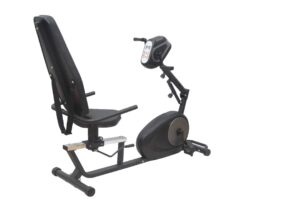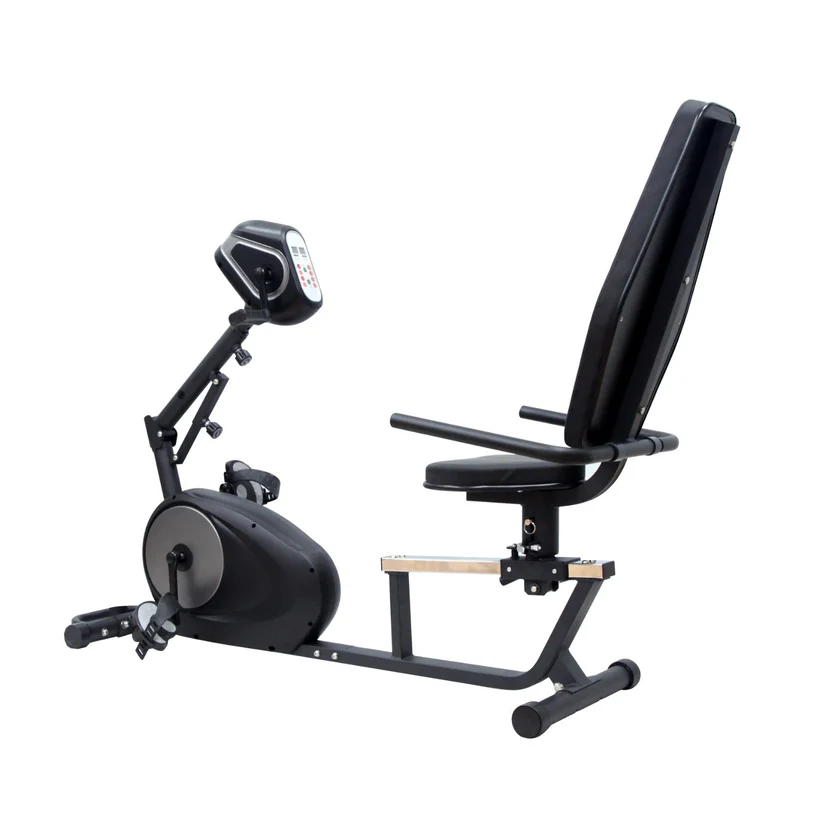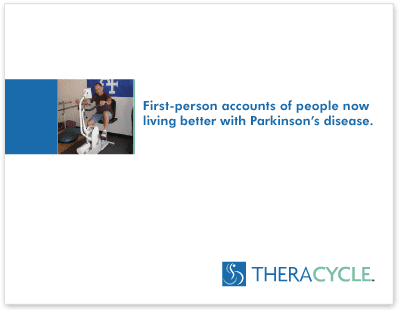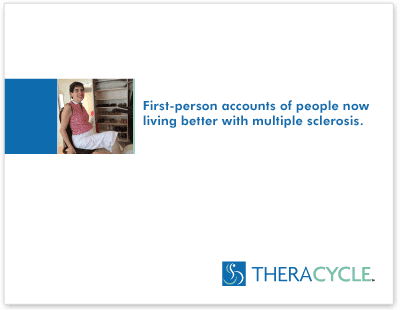- ›
- Conditions
- ›
- Theracycle & Multiple Sclerosis
Multiple Sclerosis (MS) & Benefits of Exercise: Using Motor-Assisted Bike Therapy
 Theracycle is a bike therapy for multiple sclerosis (MS) patients. Unlike traditional exercise equipment, Theracycle offers a semi-recumbent home exercise bike for MS with unique motor-assisted technology that helps you to perform MS exercises more easily and more effectively. Our Multiple Sclerosis exercise equipment helps MS patients to not only maintain the drive to stay fit and active, but our exercise bike for MS also helps to reduce MS symptoms so that you can get back to doing the things you love!
Theracycle is a bike therapy for multiple sclerosis (MS) patients. Unlike traditional exercise equipment, Theracycle offers a semi-recumbent home exercise bike for MS with unique motor-assisted technology that helps you to perform MS exercises more easily and more effectively. Our Multiple Sclerosis exercise equipment helps MS patients to not only maintain the drive to stay fit and active, but our exercise bike for MS also helps to reduce MS symptoms so that you can get back to doing the things you love!
Attempting to find the strength to continue with an exercise routine while battling the symptoms of MS is a tall order. Pain, swelling, and spasms can present a challenge to living well with MS.
However, our motorized technology assists MS patients through their exercise regimen so they can enjoy an at-home workout safely, securely and with confidence. Theracycle’s durable construction and whisper-quiet motor combine a safe and effective complement to any Multiple Sclerosis therapy program and will keep MS patients moving towards their physical and health goals.
Neuroplasticity, or brain plasticity, is the mechanism your brain uses to rewire and heal itself. Research supports that stimulating neuroplasticity can allow your brain to recover lost motor skills. According to studies, focusing on high repetition exercises can help stimulate neuroplasticity and improve your mobility. The Theracycle Multiple Sclerosis exercise bike assists those with limited mobility to perform high repetition exercises, which can help stimulate neuroplasticity in the brain and improve lost motor skills.
Multiple Sclerosis (MS) Society Financial Assistance Program Eligibility Criteria
For the MS Society to assist a person with MS with exercise equipment from Theracycle, they must meet the following eligibility criteria:
- Person must have a diagnosis of multiple sclerosis (MS) – this individual will need verification of this from their physician
- This individual must have a prescription for a Theracycle/medical necessity verification/letter that this is safe for the person to use and must be signed by a physician/OT/PT or some medical professional who provides care for said individual
- Individual must be at or below 400% of the Federal Poverty Level as far as income – the chart for this can be found here: Federal Poverty Guidelines
Upon confirmation of the criteria above, please contact an MS Navigator to finalize eligibility for financial assistance. For your convenience, you may download the National Multiple Sclerosis Society Financial Assistance Agreement here.
You can reach an MS Navigator by phone at 1-800-344-4867 or send an email on the MS website at this link: Contact an MS Navigator
Users of Theracycle’s Exercise Equipment for Multiple Sclerosis Find They Benefit From:
- Reduced fatigue
- Reduced leg stiffness and spasms
- Improved balance and gait
- Improved mobility and flexibility
- Improved motor control
Why Those with Multiple Sclerosis (MS) Should Stay Active
In a recent meta-analysis of research into the medical efficacy of exercise for MS patients1, the authors evaluated results based on the Expanded Disability Status Scale (EDSS). While there is a great degree of variability in experiment construction, the size of the population invited to participate, and the methods of evaluation of impact across the 20 studies included in the authors’ analysis, the key findings come from studies that focused on Progressive Resistance Exercise (PRE).
In studies like the one published by Cakit et al, in the Association of Academic Psychiatrists’ American Journal of Physical Medicine & Rehabilitation2, MS patients showed significant improvements after 8 weeks’ participation in a PRE or forced exercise regimen as compared to a control group that engaged in no such activities. A separate study published in the Multiple Sclerosis Journal found statistically significant improvement in the 2-minute walk test for each of three exercise intensities3 – continuous (at 45% of peak power), intermittent/interval (30 seconds on, 30 seconds off, at 90% peak power), and combined (10 minutes intermittent, then 10 minutes continuous). The 55 participants showed improvement by 22’11” (+/- 8’5”) in the 2-minute walk test after 6 weeks, with subsequent evaluations at the 12-week conclusion of the program and at a 24-week follow-up showing no significant change.
A key finding in Collett et al.’s analysis was reports of adverse events—leg pain while cycling, predominantly—from participants in the intermittent and combined groups. This shows that, while higher-intensity exercise might be of greater benefit to patients with MS looking to maintain their mobility and limit the impact of the progressive neurological condition, such activities are not always well tolerated—raising the need for a means of maintaining physical activity at sufficient levels of vigor when the body itself may not physically be able to endure those same actions that are crucial to maintaining a positive medium- and long-term outlook while living with MS.
A second literature review, this one published in the Journal of Neurology4, scoured the PubMed database for studies meeting eligibility criteria including:
- Clinical diagnosis of MS free of exacerbation; and,
- Intervention with exercise therapy, measured as activities of daily living (ADL; for example, placing dishes on an elevated shelf, stand-walk-sit tests, etc.)
The author identified 72 articles; 11 met the criteria for academic rigor to warrant inclusion in their analyses. Across the 591 participants in those 11 studies, the author found exercise therapy to have a beneficial effect in patients with MS.
Theracycle is the Best Recumbent Exercise Bike for MS
All of the above studies have considered exercise as it affects patients with MS who are free of exacerbation. One study, however, also looked at the effect of a passive cycling exercise program on non-ambulatory progressive MS patients5. Patients used a motorized exercise bike similar to a Theracycle over a 10-week study period, engaging in 3 weekly sessions consisting of 20 minutes of lower limb passive cycling exercise, with lower limb spasticity assessed at 10 weeks, 3 months, and 6 months, using the Modified Ashworth Score (MAS), with results across the 40 study participants strongly indicating that passive exercise contributed to a significant decline in the MAS for several muscles and muscle groups associated with limb spasticity and balance.
Research also supports focusing on high repetition exercises can help stimulate neuroplasticity (the mechanism your brain uses to rewire and health itself) and improve your mobility.
Doctors, physical therapists, and researchers continue to discover the benefits of Multiple Sclerosis exercise for MS patients. Our MS customers love their Theracycle for its proven efficacy in reducing symptoms and improving overall quality of life.
Additional Information on MS
MS Symptoms | Types of MS | MS and Exercise | Benefits of Exercise for MS | FAQs
Are you ready to improve the quality of your own life? Call us today!
Call us: 1.800.367.6712
Learn More About Using Theracycle as a Supplemental Multiple Sclerosis Treatment »
1. Andrea Döring, Caspar F Pfueller, Friedemann Paul, and Jan Dörr · Exercise in multiple sclerosis – an integral component of disease management · EOMA Journal, Dec 2011, doi: 10.1007/s13167-011-0136-4
2. Cakt, Burcu & Nacir, Bari? & Genc, Hakan & Saracoglu, Meryem & Karagöz, Aynur & Erdem, Hatice & Ergun, Ufuk. · Cycling Progressive Resistance Training for People with Multiple Sclerosis A Randomized Controlled Study · American journal of physical medicine & rehabilitation / Association of Academic Physiatrists, March 2010, DOI: 10.1097/PHM.0b013e3181d3e71f
3. Johnny Collett, Helen Dawes, Andy Meaney, Cath Sackley, Karen Barker, Derick Wade, Hooshang Izardi, James Bateman, Joan Duda, Elizabeth Buckingham · Exercise for multiple sclerosis: a single-blind randomized trial comparing three exercise intensities · Multiple Sclerosis Journal, January 2011, Volume: 17 issue: 5, page(s): 594-603
4. Sá, M.J. · Exercise therapy and multiple sclerosis: a systematic review. · Journal of Neurology 261, 1651–1661 2014.
5. M.A. Guyot, P. Hautecoeur b, S. Demaille, C. Donzé · Effects of a 10-week passive cycling exercise on spasticity in high-level disability multiple sclerosis patients · Journal of Neurology, , October 2012, Doi : 10.1016/j.rehab.2012.07.519
Customer Testimonials
My wife has MS and is totally dependent on others to assist her, and for the last 15 + years the Theracycle has been her means of keeping her muscle tone in her legs and arms. I must admit my wife is lost without getting her daily one-hour workout on the cycle. The Theracycle is the best piece of exercise equipment we have purchased, and we highly recommend it. Thank you all for an outstanding product.” Don & Sue Allen
Lafayette, IN
My wife Sarina has had MS for 25 years. She tried regular physical therapy exercise equipment, but she had no strength. She always feels better after she rides her Theracycle. She finds it very easy and very comfortable. What would I tell people? Do you have the will to go on? Or give up? Sarina is the type who is very willful. By all means, get this machine.” Joe Cardillo
North Stonington, CT
Theracycle has been great for me. I used to be very athletic. I was a 5K runner, and a downhill and cross-country skier. My MS has stopped me from doing these things. After sitting in a wheelchair all day, Theracycle helps unstiffen my legs and reduce the swelling in my ankles. By using the Theracycle, I get that same feeling back in my legs I once felt by running and skiing. Also, it helps keep my blood pressure down. This machine has already given me more of a workout than I have had literally in years!” Mark Mathews
New Mexico
Read more testimonials from Theracycle users with Multiple Sclerosis »










